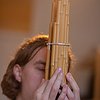Part 1
Name: Mattias Hållsten
Nationality: Swedish
Occupation: Composer, musician
Current release: Mattias Hållsten's Breathing, bowing is out via Thanatosis.
Recommendations on the topic of sound and just intonation:
James Tenney (2019) From Scratch: Writings in Music Theory, University of Illinois Press.
Alvin Lucier (2018) Eight Lectures on Experimental Music, Wesleyan University Press.
Thomas Nicholson & Marc Sabat (2018) Fundamental Principles of Just Intonation and Microtonal
Composition
Kristofer Svensson (2020) Varieties of Just Intonation
If you enjoyed this Mattias Hållsten interview and would like to know more about his music, visit his official homepage. He is also on Facebook, and Soundcloud.
Can you talk a bit about your interest in or fascination for sound and what sparked it?
It’s hard to pinpoint exactly what sparked my fascination with sound. But I do remember getting very interested in synthesis as a teenager. One key moment was probably when I started using the DAW Reason, which offers incredible flexibility through the virtual patch cables.
In terms of my interest in tuning, I have one memory of tuning my guitar after learning about just intonation, specifically how a justly tuned major third is tuned lower than its equal temperament counterpart. Without consciously thinking about it, I had tuned the B string of my guitar justly in relation to the open G string, and I noticed how an E major chord sounded horribly out of tune due to the fifth (the B string) being very flat.
For me, this experience really cemented the idea that a just intonation practice in many ways has to be grounded in listening, and tuning by ear rather than only entering frequency ratios into the computer.
What have been some of the most beautiful/intriguing sounds you’ve heard and some of the most beautifully/intriguingly sounding places you’ve been to?
One particularly vivid memory is from my six-week trip to Japan last year, while visiting the Nison-in (二 尊院) temple in Kyoto. In their garden, as is common in Zen gardens, there are many sound-making devices whose original purpose is keeping animals away, that are now incorporated as conscious aesthetic elements. They had what’s known as a shishin-odoshi (鹿威し), a bamboo tube that is open on one side and closed on the other.
The tube is attached to a pivot point, and as the closed side is heavier than the open side the closed side rests against a rock. The construction is positioned under a second bamboo tube, pouring water into the open side of the main bamboo tube, and as it gets filled with water, the weight ultimately makes the tube pivot to the open side, releasing the water and making the tube pivot back to its original state. In the process, the heavier side of the tube hits the rock it was previously resting on, which causes a beautiful percussive sound.
As many Japanese temples, Nison-in has a porch facing the garden. I sat there, and every time the shishin- odoshi struck the rock it created the most beautiful moment of silence. However, what happened was not that the visitors, birds etc. seized to make noise. Instead, this seems to have been an auditory effect happening withing my own hearing, as if the sound of the shishin-odoshi caught my attention to the point where no other sounds became relevant to my cognitive system. I think it revealed something very profound about my hearing.
In addition to this, the temple also had a large bell, closer to the entrance of the temple area, which visitors were allowed to strike at will. Softly in the distance, I could hear these strikes to the bell at irregular time intervals, and that sound, together with the regular sound of the shishin-odoshi, created this incredible spontaneous music. It was completely mesmerizing.
The human voice is one of the first sounds we are exposed to, even before we understand the exact meaning of words. Are you, too, interested in voices and language, the rhythm of speech, the timbres of different voices – and do you think these qualities find their way into your sound work?
I started singing in a choir at a young age. So the musical capacity of the human voice has always been present. I also have memories of studying jazz music in high school, and reflecting on how singing along with my playing would lead to much more coherent phrasing. To me, this reveals how much of typical phrasing in jazz, as well as a lot of musics with melodic emphasis, is inherently tied to human breath and the limits that our lungs impose on us.
As a piano player, I was told by my teacher to “think like a horn player”, and create “imaginary breathing pauses”. This was really eye-opening for me.
Although my music, over the last years, has consisted of primarily long notes, which is not coherent to this idea of phrasing in accordance to breathing, learning to play the shō is really re-incorporating breathing into my music. In fact, this played a key role in my latest release Breathing, bowing.
There can be very deep/high/loud/quiet/grating/delicate sounds and many more. Are there extremes in sound you are particularly interested in - and what response do they elicit in you?
I used to be much more interested in very loud sounds, or rather I had the idea of wanting my music to be played as loud as possible without being unbearing.
While I still think this serves a purpose, I now quite enjoy softer music. When playing the shō in solo settings, for example, I try to avoid amplifying the instrument and if there’s electronics, I try to match its loudness to the sound of the shō.
The same goes for really low sounds – although it is of course very satisfying to hear a really low bass note played through good sub woofers.
Deep listening, audiowalks, meditation, listening with both eyes closed, and the like can sharpen our sense of hearing – which techniques or experiences have worked for you to create a greater awareness of the sound aspects of music and our environment?
I approach these things in a pretty laid back manner, and tend to just listen for and get excited by environmental sounds that sound nice. Closing one’s eyes of course helps. In general, I find the institutional aspect of the whole Deep Listening apparatus a bit off-putting – it’s not like you need an instructor to experience sounds in new ways.
However, my interest in slow music probably comes in part from how slower sounds afford the listener the possibility to spend a bit more time with them, and really consider how they behave harmonically, timbrally and spatially.
As with my previously mentioned experience at the Nison-in temple in Kyoto, I enjoy music and sounds that reveals something about one’s hearing.
Over the course of your development, what have been your most important instruments and tools?
When I started studying at the Royal College of Music (KMH) in Stockholm in 2016, I got exposed to many different musicians and composers who in different ways have ties to KMH, Fylkingen and Elektronmusikstudion.
One of those was Marcus Pal, who introduced me to the programming environment SuperCollider as well as just intonation, which have remained some of my most important tools and frameworks for composition.
More recently, going on a day trip with my teacher Ko Ishikawa to shō builder Mizushima-sama to purchase my own instrument was an incredible experience, and the instrument I purchased is really of exceptional quality. I get inspired every time I play it.
Could you describe your creative process on the basis of one of your sounds, pieces, or live performances that’s particularly dear to you, please?
One of the projects I have become involved in recently is Catherine Christer Hennix’s Kamigaku Ensemble, whom I performed with in both Stockholm and Oslo earlier this year. The group features Hennix and me on shō, as well as Ellen Arkbro and Susana Santos Silva on trumpet, Hilary Jeffery on trumpet / trombone and Marcus Pal on electronics.
[Read our Ellen Arkbro interview]
Due to the nature of the electronics system, the music is extremely sensitive to intonation. To my understanding, the shō is not traditionally regarded as an instrument with the possibility of intonation while playing – like a piano or organ, the instrument is tuned beforehand and the pitches of the pipes are regarded as fixed.
However, due to the fidelity in tuning required for this music, I started noticing how much my breathing strength as well as if I played the pipes on inhale or exhale affected the intonation. We’re talking about a couple of cents here, but in this music those cents mattered a lot.
Performing this music really opened up my ears and mind to the huge potential for intonation on the shō, and sparked my imagination towards more music and artistic expression in the future. I think my experience might be akin to how string players discover how much their bowing pressure affect the pitches they produce.






